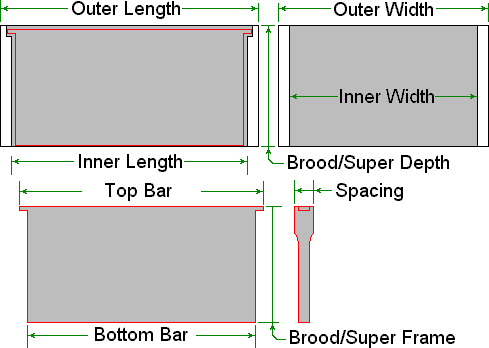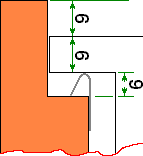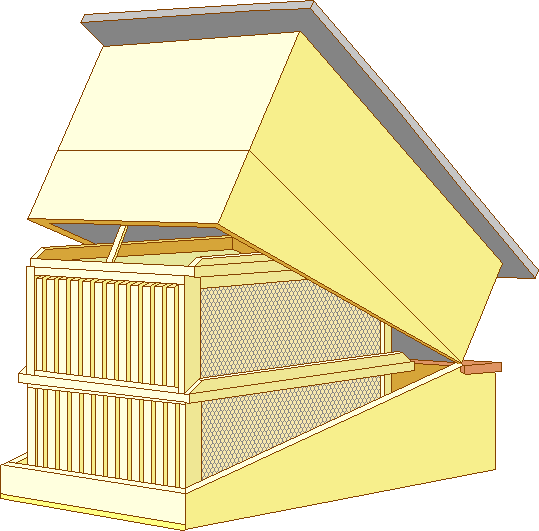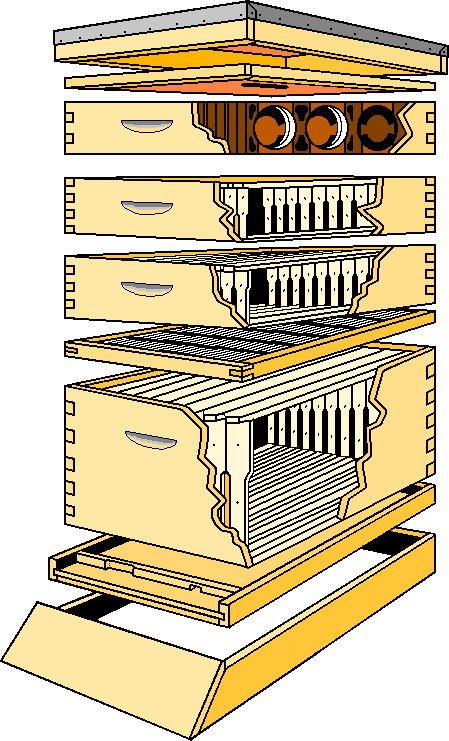Other Beehives
|
|
|
|---|
|
Other Beehives |
The Langstroth Bee Hive |
|---|
Langstroth equipment accounts for about 75% of worldwide beekeeping kit, however within that term 'Langstroth standard' there are about ninety sub species, some of which are totally incompatible with each other.
Some of the Imperial dimensions for the height of a brood box that I have found, have given 9 7/16" (1930 Hooper & Morse), Wedmore stated 9 1/2" in 1932, and yet others at 9 9/16" (New Zealand 1990). The 9 5/8" measure must be recent due to the use of timber that is still 'green'. The older the information the shorter the box which suggests that the timber was progressively better seasoned the further we go back in time. Or perhaps the bees of yesteryear required a smaller bee space???
There are dimensional and construction details here for U.K. Langstroth hives. This information is by kind permission of the Scottish Beekeepers Ass'n.
Some of the information for the following table has come from Nick Wallingford's website. Values rounded to nearest integer.
| Outer Length | Inner Length | Outer Width | Inner Width | Brood Depth | Brood Frame | Super Depth | Super Frame | Top Bar | Bottom Bar |
|---|---|---|---|---|---|---|---|---|---|
| American Langstroth (from imperial measurements) | |||||||||
| 508 | 464 | 416 | 372 | 241 | 232 | 168 | 159 | 483 | 448 |
| Californian Langstroth (from imperial measurements) | |||||||||
| 508 | 470 | 413 | 375 | 245 | 232 | 168 | 159 | 483 | 448 |
| Australian Langstroth (from imperial measurements) | |||||||||
| 508 | 464 | 406 | 362 | 241 | 232 | 168 | 159 | 483 | 448 |
| Canadian Langstroth (Courtesy British Columbia Dept of Agriculture www.al.gov.bc.ca/apiculture) | |||||||||
| 507 | 469 | 418 | 380 | 241 | 232 | 168 | 159 | 483? | 448? |
| British Langstroth (APEX Enterprises Metricated dimensions) | |||||||||
| 508 | 464 | 413 | 370 | 242 | 232 | 146 | 137 | 483 | 448 |
| 9 Frame British Langstroth (APEX Enterprises Metricated dimensions) | |||||||||
| 508 | 464 | 376* | 333* | 242 | 232 | 146 | 137 | 483 | 448 |
| 11 Frame British Langstroth (APEX Enterprises Metricated dimensions) | |||||||||
| 508 | 464 | 468* | 434* | 242 | 232 | 146 | 137 | 483 | 448 |
| New Zealand Langstroth (from imperial measurements) | |||||||||
| 508 | 464 | 406 | 362 | 241 | 232 | 184 | 175 | 481 | 452 |
| New Zealand Langstroth (New Metric Standard) | |||||||||
| 505 | 465 | 405 | 365 | 238 | 230 | 185 | 177 | 482 | 450 |
| 8 Frame New Zealand Langstroth (New Metric Standard) | |||||||||
| 505 | 465 | 353 | 310-313 | 238 | 230 | 185 | 177 | 482 | 450 |
| French Langstroth (Metric from inception) | |||||||||
| 506 | 452 | 506 | 452 | 258 | 228 | ?? | ?? | ?? | 436 |
| Danish 10 frame Langstroth (Swienty styropor) (Courtesy Swienty catalogue) | |||||||||
| 540 | 463 | 450 | 374 | 240 | 232 | 165 | 158 | 487 | 450 |
| Danish 13 frame Langstroth (Rea-dan Skinned polyurethane foam) | |||||||||
| 508 | 465 | 508 | 465 | 243 | 234 | ?? | ?? | 480 | 448 |
| Greek Langstroth (Metric from inception) | |||||||||
| 507 | 465 | 417 | 375 | 244 | 230 | ?? | ?? | 480 | 450 |
| Mexican Langstroth (Metric from inception) | |||||||||
| 515 | 477 | 405 | 367 | ?? | ?? | 150 | 141 | 495 | 450 |
| 12 frame type used by Erik Osterlund | |||||||||
| 508 | 464 | 508 | 464 approx. | 145 | 137 | 145 | 137 | 483 | 448 |
|
Notes... Hoffman spacing is 35 mm except Greece which is 36 mm and New Zealand which is 33 mm (older NZ was 33.4 mm) and Mexico was/is 33 mm. Some deep frames made by APEX were 37 mm wide and some shallow frames made by APEX were 38 mm wide. ?? = Unknown at present. Should you know any of these dimensions please use the Email facility at the bottom of the page so that I can update this table. * = requires confirmation from original data when found. |

|
|---|
The 168 mm depth super is sometimes known as 'Dadant depth' or an 'Illinois medium', some operations use this type of box and frame for all parts of the hive.
|
There is some variation in the depth of seating of the frames in different standards, But I only know the APEX details which were 9 mm above the lug, 9 mm lug, 6 mm under the lug, giving a 1 mm clearance under the frames. The sketch at right shows the Apex details, the frame rest (known as a 'frame runner' in UK) is made from folded Zintec sheet, the 6 mm gap under the lug dramatically reduces propolis accretion and is a common feature in most British bee hives. |

|
|---|
There is another issue here as well... In the UK we work to fine tolerances of 0.1 mm (0.004") using well seasoned, selected timber. In USA the timber is not seasoned so much and will thus 'move' a little in service, also the manufacturing tolerance used in USA can be as high as 1/16" (1.5875 mm) and this means that 3/8" bee space, or larger, will be commonly used by manufacturers simply to accommodate these discrepancies.
Jumbo versions are sometimes confused with Dadant, but the Dadant is distinguished by and identifiable as having 38 mm frame spacing. Both Dadant and Langstroth Jumbo have nominal frame side depth as 286 mm and box depth of 308 mm, I have measured some boxes at 306 mm and some at 304 mm, but these were many years old and could have been worn as well as shrunken. I have some more details, but at the time of writing they were buried in my filing system, when they come to light they will be added.
Additional Danish information from... Thor Bue Hansen.
The modern Langstroth hive bears very little resemblance to the hive that Langstroth designed. His original design was a set of crates that carried the frames, the crates being inserted into a box like outer cover... The illustration below was taken from an old woodcut and shows an early version, but I do not know an exact date.

|
This more modern Langstroth type design, has an extremely shallow stand that is intended to rest on the ground, which in turn would render the woodwork somewhat damp, but the floor (bottom board) is solid and unventilated, which both makes the dampness worse and does not allow a substantial drop for fallen varroa mites. or a path under the hive to allow a drying current of air to pass. This drawing has been made using one that occurred on the Eastern Panhandle Beekeepers Association website as an example. At 01-09-2019 this website was no longer available. R.P. The uppermost super is a rack that accepts "Ross Rounds" plastic section frames that are used for the production of round sections. |

|
|---|
Dave Cushman.
Page created Summer 2000
Page updated 03/12/2022